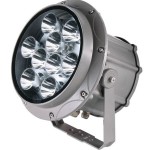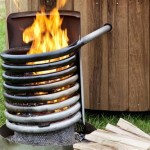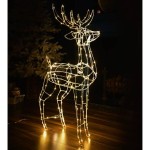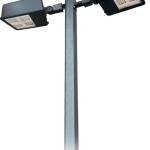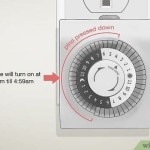How To Daisy Chain Outdoor Lights
Daisy chaining outdoor lights offers a convenient and cost-effective way to illuminate patios, gardens, and other outdoor spaces. This method involves connecting multiple light strings end-to-end, creating a continuous run of illumination from a single power source. Understanding the process, safety considerations, and various connection methods can ensure a successful and safe outdoor lighting setup.
Understanding Daisy Chaining Basics
Daisy chaining refers to connecting multiple devices in a series, where the output of one device becomes the input for the next. In the context of outdoor lighting, this involves connecting the female end of one light string to the male end of another. This process can be repeated with multiple strings, creating a long chain of lights powered by a single outlet. The key limitation to daisy chaining is the maximum power capacity of the first string in the chain, as it carries the electrical load for all subsequent strings.
Before beginning any electrical work, it's crucial to understand the power requirements of the lights and the capacity of the power source. Each light string has a wattage rating, representing its power consumption. Adding multiple strings together increases the total wattage drawn from the outlet. Exceeding the outlet's capacity or the first string's maximum connected wattage can lead to tripped breakers or, in more severe cases, overheating and fire hazards. Consult the manufacturer's instructions for specific wattage limitations.
Choosing the Right Lights for Daisy Chaining
Not all outdoor lights are designed for daisy chaining. Look for light strings specifically labeled as "connectable" or "end-to-end connectable." These strings are equipped with male and female plugs designed for secure and weather-resistant connections. The packaging will typically indicate the maximum number of strings that can be safely connected together. Using non-connectable lights or exceeding the manufacturer's recommendations can create unsafe electrical conditions.
Consider the type of bulbs used in the light strings. Incandescent bulbs tend to draw more power than LED bulbs, limiting the number of strings that can be daisy-chained. LED lights offer energy efficiency and longer lifespans, making them a more suitable choice for extensive daisy-chained setups. Additionally, consider the environment where the lights will be installed. Choose lights with appropriate weatherproofing ratings for outdoor use, ensuring they can withstand rain, snow, and other environmental factors.
Methods for Connecting Lights
The most common connection method involves using the built-in male and female plugs on the ends of connectable light strings. Ensure the plugs are securely connected and free from debris or moisture. For added security, consider wrapping the connections with electrical tape to create a tighter seal and further protect against moisture. This step is especially important in areas exposed to rain or sprinklers.
Some light strings might utilize threaded connectors, requiring twisting the ends together to establish a connection. These connectors often feature gaskets to enhance weather resistance. Ensure the connection is tight and properly sealed to prevent water ingress. Alternatively, specialized connectors or adapters might be needed for specific types of light strings or to connect strings with different connector types. Always consult the manufacturer's instructions for proper connection procedures.
Safety Precautions for Daisy Chaining
Before working with any electrical connections, ensure the power is turned off at the breaker box. This critical safety step prevents electric shocks. Inspect the light strings for any damage, such as frayed wires or cracked insulation, before connecting them. Damaged strings should be replaced immediately to avoid hazards. Avoid overloading circuits by connecting too many strings or exceeding the maximum wattage rating of the first string in the chain. Overloading can lead to tripped breakers or overheating.
Outdoor electrical connections are susceptible to moisture, which can create a shock hazard. Ensure all connections are weatherproof and properly sealed. Consider using weatherproof electrical tape or specialized waterproof connectors for added protection. Regularly inspect the lights and connections for any signs of damage or wear. Replace any damaged components promptly. When hanging lights outdoors, use appropriate hanging hardware and ensure the lights are securely fastened to prevent them from falling or becoming damaged.
Troubleshooting Common Issues
If a section of the daisy chain fails to illuminate, check the connections between the strings. A loose or faulty connection can interrupt the flow of electricity. Unplug the strings and inspect the connections for any signs of damage or corrosion. Tighten loose connections or replace damaged plugs. If a string is faulty, it will need to be replaced. If an entire chain of lights fails to work, check the circuit breaker to ensure it hasn't tripped. Reset the breaker if necessary. If the problem persists, the issue could be with the power outlet or the first string in the chain.
Test the outlet with another device to confirm it's functioning correctly. If the outlet is working, the problem likely lies with the first light string. Try replacing the first string with a known working string to isolate the issue. If the lights still don't work, consult a qualified electrician to diagnose and address the problem. Never attempt to repair electrical issues beyond your expertise. Electrical safety should always be a top priority.

How To Daisy Chain Lights Together Landscape Lighting

How To Daisy Chain Lights 13 Steps With Pictures Wikihow Led

Installation Help For Outdoor Lighting
How To Connect Two Light Fixtures Quora

How To Daisy Chain Lights 13 Steps With Pictures Wikihow

How To Daisy Chain Lights Together Landscape Lighting

How To Daisy Chain Lights 13 Steps With Pictures Wikihow

Low Voltage System Layout Landscape Lighting Supply Company

How To Daisy Chain Lights Together Landscape Lighting

How To Daisy Chain Lights 13 Steps With Pictures Wikihow
